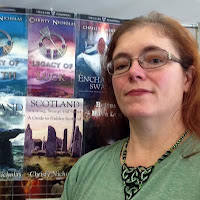Celtic Christianity
versus Roman Christianity
By Christy Nicholas
My
next novel, Misfortune of Time (due out July 2018), takes place in 1055AD in
Ireland. Much of the first portion of the book is set in Clonmacnoise, among
the monks and priests that lived and worked in this large, bustling abbey.
During
this time, the priests and bishops of Irish and Scottish churches were more
likely to follow the dictates and rules of what was known as Ionan Christianity,
though we now mostly call it Celtic Christianity. These dictates differed from
the commonly accepted practices in Rome and the rest of Western Christendom in
several key points. While this was especially true in the 6th and 7th
centuries, before the Synod of Whiby, many traditions were still followed well
into the 12th century.
One
of the reasons for this dichotomy was who spread the Word. Some of the early
teachers of the ideals of monastic life in these areas were Saint Dubric in
Wales, Saint Columba in Scotland (who founded the monastery at Iona) and, of
course, Saint Patrick in Ireland. They had their own ideas of how to be a
Christian monk long before Rome decided on a common way. Saint Patrick had been
born in Wales and, presumably, raised on the tradition already in place there.
While Christianity had appeared in Ireland before the arrival of Saint Patrick,
he is credited with the widespread adoption of the religion. Saint Columba then
did a similar spread across the Scottish lands.
 |
| St. Patrick |
In
all these lands, but especially in Ireland, monastic communities rose
dramatically in the following cemeteries, each following a specific set of
rules for their order.
Some
of the differences in various regions (not all) include:
· The
calculation of the date of Easter
· The shape and
style of the monastic tonsure (shaving of the head for monks)
· The method of
private penance to a priest
· Monastic
isolation or hermitage (peregrination pro Christo)
· The ability
for priests to marry and have families
· Differing
views on fasting and corporal punishment (Rule of Columbanus)
· Baptism
tradition details
 |
| The Roman Tonsure |
In
addition to the differences between Celtic and Roman Christianity, there were
also remnants of the Gaelic Brehon Law at work during this time. Many of these
laws still held sway through to the Norman invasion of Ireland in the 12th
century.
Some
of the Brehon Laws included:
· Progressive
treatment of women, giving greater freedom, independence and rights to
property, rights later removed by Canon Law
· The right to
divorce on many grounds, including impotence or homosexuality
· Brehon law
allowed and gave rules for polygamy (usually wives)
· Relative
status of kings versus priests, and the ranks of each
· Brehon law
did not typically distinguish between legitimate and illegitimate children
· Brehon law
espoused payment for crimes in wealth (wergild) instead of capital punishment
The
law in medieval Ireland was an ever-shifting beast, and often what one chief or
bishop believed was different from what his neighbor believed. The dying
tradition of having a Brehon at each chief’s court, an expert on the law, meant
that more and more, the chiefs turned to the church as an expert on such
matters, and thus church law came into more and more use as the centuries wore
on.
Christy Nicholas
Christy Nicholas, also known as Green Dragon, is an author, artist and accountant. After she failed to become an airline pilot, she quit her ceaseless pursuit of careers that begin with ‘A’, and decided to concentrate on her writing. Since she has Project Completion Disorder, she is one of the few authors she knows with NO unfinished novels.
Christy has her hands in many crafts, including digital art, beaded jewelry, writing, and photography. In real life, she’s a CPA, but having grown up with art all around her (her mother, grandmother and great-grandmother are/were all artists), it sort of infected her, as it were.
She wants to expose the incredible beauty in this world, hidden beneath the everyday grime of familiarity and habit, and share it with others. She uses characters out of time and places infused with magic and myth.
Combine this love of beauty with a bit of financial sense and you get an art business. She does local art and craft shows, as well as sending her art to various science fiction conventions throughout the country and abroad.




This is such an interesting time in history for the Church. I explore this in my own books. Absolutely fascinating.
ReplyDeleteThank you so much for hosting me! It's amazing what rabbit-holes you can research into...
ReplyDelete